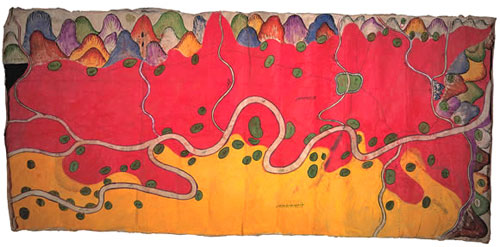I saw a number of books with map themes at the Codex Book Fair last week. But my best treat was at lunch before the fair, when my friend Sharon produced 2 books to show me: You Are Here: Personal Geographies and Other Maps of the Imagination by Katharine Harmon and The Atlas of Experience by Louise Van Swaaij & Jean Klare.
![]() In You Are Here, Harmon says “maps intrigue us, perhaps none more than those that ignore mapping conventions” and then asks what makes a map an accurate depiction of the world and does accuracy matter? She answers with essays, quotations, poems and, yes, lots of maps. She’s built “an idiosyncratic collection of maps that transcend the norm, either because of the mapmaker’s personal viewpoint, or sense of humor, or ingenuity, or all of the above. These are maps of the imagination, as all maps are, only more so.” There are hours and hours of looking to be done with this book, but at the bottom of this post is one Sharon especially pointed out to me: “Shan map relating to a border dispute between (British) Burma and China along the Nam Mao River”. You can read an excerpt from the book and see a dozen or so maps in this article from Duke Magazine.
In You Are Here, Harmon says “maps intrigue us, perhaps none more than those that ignore mapping conventions” and then asks what makes a map an accurate depiction of the world and does accuracy matter? She answers with essays, quotations, poems and, yes, lots of maps. She’s built “an idiosyncratic collection of maps that transcend the norm, either because of the mapmaker’s personal viewpoint, or sense of humor, or ingenuity, or all of the above. These are maps of the imagination, as all maps are, only more so.” There are hours and hours of looking to be done with this book, but at the bottom of this post is one Sharon especially pointed out to me: “Shan map relating to a border dispute between (British) Burma and China along the Nam Mao River”. You can read an excerpt from the book and see a dozen or so maps in this article from Duke Magazine.
![]() The Atlas of Experience is written and drawn by 2 Dutch cartographers using traditionally map-making conventions, but charting such “lands” as Secrets, Knowledge, Bad Habits, Home, Boredom, Mountains of Work, and Haute Cuisine. Each map is accompanied with quotes and commentary.
The Atlas of Experience is written and drawn by 2 Dutch cartographers using traditionally map-making conventions, but charting such “lands” as Secrets, Knowledge, Bad Habits, Home, Boredom, Mountains of Work, and Haute Cuisine. Each map is accompanied with quotes and commentary.


Fascinating. I teach kids to map things, their rooms, the trip between home and school. The best maps come from the kids who understand mapping conventions and usefulness the least. David Sobel writes about map making with kids. An exercise I use with kids is to set up a landscape on a large table, complete with anything that could inhabit the landscape. This they draw, juggling all kinds of design decisions. …then there’s the adult version of the Masquerade rabbit hunt: Geo-chaching (sp?). Because isn’t that what mapping does? Help us locate or describe a treasure.